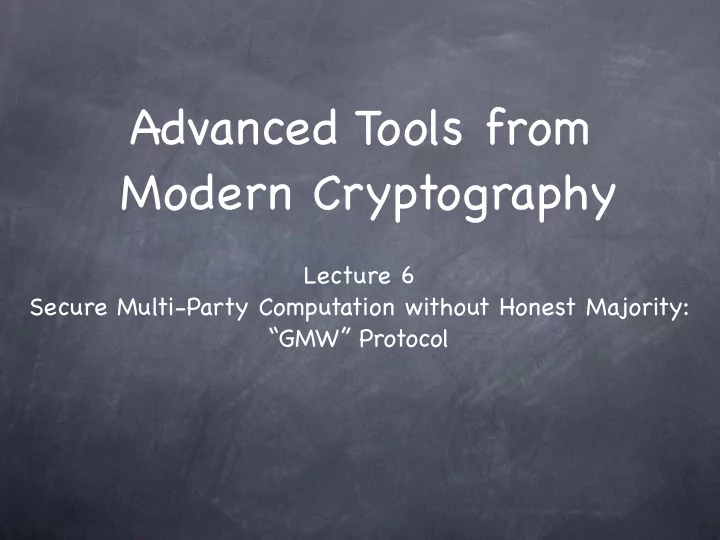

Advanced Tools from Modern Cryptography Lecture 6 Secure Multi-Party Computation without Honest Majority: “GMW” Protocol
MPC without Honest-Majority Plan (Still sticking with passive corruption): Two protocols, that are secure computationally The “passive-GMW” protocol for any number of parties A 2-party protocol using Yao’ s Garbled Circuits Both rely on a computational primitive called Oblivious Transfer Today: OT and Passive-GMW (Not exactly the version from the GMW’87 paper.)
Oblivious Transfer Pick one out of two, without revealing If we had a trusted third which party Intuitive property: F OT transfer partial A:up, B:down A I need just up information All 2 of one t c i d e r P e W them! But can’t “obliviously” ! ! S K C O Sure T tell you S which b x 0 x 1 F x b
Is OT Possible? No information theoretically secure 2-party protocol for OT Because OT can be used to carry out information- theoretically secure 2-party AND (coming up) Computationally secure OT protocols exist under various computational hardness assumptions Will define computational security of MPC later, comparing the protocol to the ideal functionality
An OT Protocol (against passive corruption) Using (a special) public-key encryption In which one can sample a public-key without knowing secret-key c 1- b inscrutable to a ( SK b , PK b ) ← KeyGen passive corrupt receiver Sample PK 1- b Sender learns nothing about b c 0 = Enc(x 0, PK 0 ) c 1 = Enc(x 1, PK 1 ) PK 0 , PK 1 x b =Dec ( c b ;SK b ) b c 0 ,c 1 x 0 x 1 x 0 ,x 1 b F x b x b
Why is OT Useful? Say Alice’ s input x, Bob’ s input y, and only Bob should learn f(x,y) Alice (who knows x, but not y) prepares a table for f(x, ⋅ ) with D = 2 |y| entries (one for each y) Bob uses y to decide which entry in the table to pick up using 1-out-of-D OT (without learning the other entries) Bob learns only f(x,y) (in addition to y). Alice learns nothing beyond x. Secure protocol for f using access to ideal OT OT captures the essence of MPC: Secure computation of any function f can be reduced to OT Problem: D is exponentially large in |y| Plan: somehow exploit efficient computation (e.g., circuit) of f
Passive GMW Adapted from the famous Goldreich-Micali-Wigderson (1987) protocol (due to Goldreich-Vainish, Haber-Micali,…) Passive secure MPC based on OT, without any other computational assumptions Will assume that a trusted party is available to carry out OT between any pair of parties (replaced by a cryptographic protocol, later) Tolerates any number of corrupt parties Idea: Computing on additively secret-shared values For a variable (wire value) s, will write [s] i to denote its share held by the i th party
Computing on Shares: 2 Parties Let gates be + & ⨉ (XOR & AND for Boolean circuits) Plan: Similar to BGW: shares of each wire value will be computed, with Alice holding one share and Bob the other. At the end, Alice sends her share of output wire to Bob. w = u + v : Each one locally computes [w] i = [u] i + [v] i w [w] 1 [w] 2 + + + u v [u] 1 [v] 1 [u] 2 [v] 2
Computing on Shares: 2 Parties What about w = u ⨉ v ? [w] 1 + [w] 2 = ( [u] 1 + [u] 2 ) ⨉ ( [v] 1 + [v] 2 ) Alice picks [w] 1 and lets Bob compute [w] 2 using the naive (proof-of-concept) protocol Note: Bob’ s input is ([u] 2 ,[v] 2 ). Over the binary field, this requires a single 1-out-of-4 OT. F OT w [w] 1 [w] 2 ⨉ u v [u] 1 [v] 1 [u] 2 [v] 2
Passive GMW Secure? View of Alice: Input x and random values it picks through out the protocol ✓ View of Bob: Input y and random values it picks through out the protocol A random value (picked via OT) for each wire out of a × gate f(x,y) - own share, for the output wire This distribution is the same for x, x’ if f(x,y)=f(x’,y) ✓ Exercise: What goes wrong in the above claim if Alice reuses [w] 1 for two × gates?
Computing on Shares: m Parties m-way sharing: s = [s] 1 +…+ [s] m Addition, local as before Multiplication: For w = u ⨉ v [w] 1 +..+ [w] m = ( [u] 1 +..+ [u] m ) ⨉ ( [v] 1 +..+ [v] m ) Party i computes [u] i [v] i For every pair (i,j), i ≠ j, Party i picks random a ij and lets Party j securely compute b ij s.t. a ij + b ij = [u] i [v] j using the naive protocol (a single 1-out-of-2 OT) Party i sets [w] i = [u] i [v] i + Σ j ( a ij + b ji )
MPC for Passive Corruption Story so far: For honest-majority: Information-theoretically secure protocol, using Shamir secret-sharing [BGW] Without honest-majority: Using Oblivious Transfer (OT), using additive secret-sharing [GMW] Oblivious Linear-function Evaluation Up next (OLE) for large fields (Exercise) A 2-party protocol (so no honest-majority) using Oblivious Transfer and Yao’ s Garbled Circuits Uses additional computational primitives and is limited to arithmetic circuits over small fields (e.g., boolean circuits) Needs just one round of interaction
Recommend
More recommend